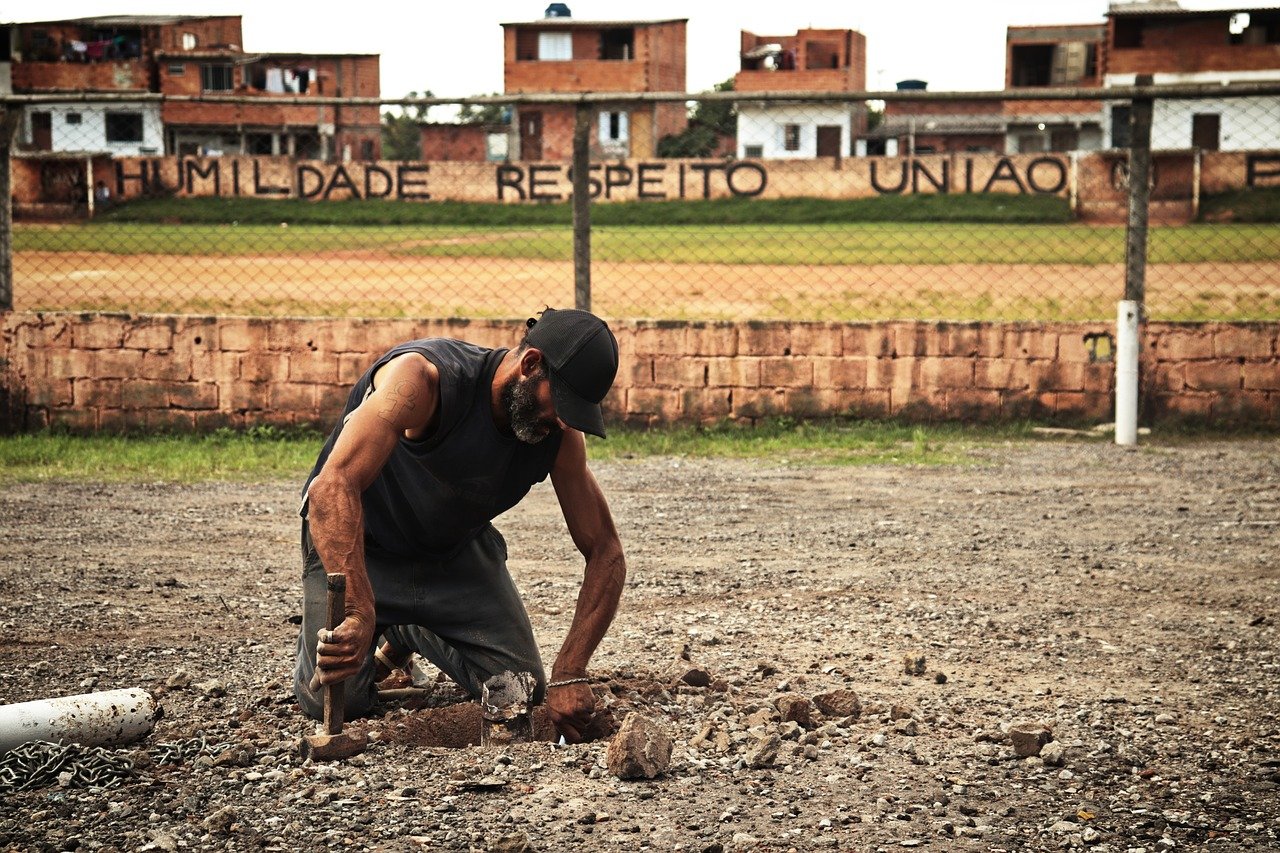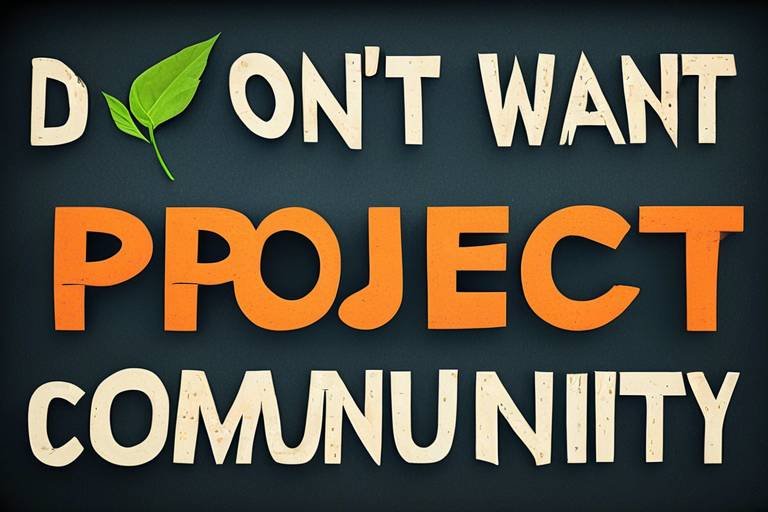How to Create a Sustainable Community Project
Creating a sustainable community project requires careful planning, dedication, and collaboration. It's not just about starting something new; it's about making a lasting impact that benefits the environment, society, and economy. To embark on this journey, you need a clear roadmap that addresses the specific needs of the community while incorporating eco-friendly practices and securing necessary funding.
Identifying community needs is the first crucial step in creating a successful project. By understanding the challenges and requirements of the community, you can tailor your initiatives to have the most significant positive effect. This involves listening to the voices of community members, assessing their needs, and identifying areas where your project can make a real difference.
Building partnerships is another key element in establishing a sustainable community project. By collaborating with local organizations, businesses, and government entities, you can leverage their resources, expertise, and networks. These partnerships can provide additional support, funding opportunities, and a broader reach for your project.
Engaging stakeholders is essential to ensure that your project remains relevant and receives the necessary support. By involving community members, leaders, and beneficiaries in the decision-making process, you can gain valuable insights, build trust, and create a sense of ownership. This involvement fosters a strong bond between the project and the community it serves.
Creating an action plan is vital for maintaining focus and accountability throughout the project. Developing a detailed roadmap that outlines goals, timelines, budget, and responsibilities helps keep everyone on track. It serves as a guiding document that ensures all efforts are aligned towards achieving the project's objectives.
Implementing sustainable practices is at the core of a successful community project. By incorporating eco-friendly and socially responsible methods, you can minimize environmental impact and promote long-term viability. This includes using renewable resources, reducing waste, and prioritizing the well-being of the community and its surroundings.
Monitoring and evaluation are ongoing processes that allow you to assess project progress, collect feedback, and measure outcomes. By regularly reviewing your project's performance, you can make informed adjustments and improvements. This continuous evaluation ensures that your project remains effective and responsive to the community's evolving needs.
Securing funding is a critical aspect of sustaining your community project. Exploring diverse funding sources such as grants, donations, sponsorships, and crowdfunding can help cover operational costs and support future growth. By diversifying your funding streams, you can reduce financial risks and ensure the long-term viability of your project.
Empowering community ownership is the key to ensuring the sustainability and legacy of your project. By encouraging active participation and leadership from community members, you create a sense of pride and responsibility. This empowerment fosters a strong community bond and ensures that the project continues to thrive even after its initial implementation.

Identifying Community Needs
When embarking on a community project, the first crucial step is identifying the specific needs of the community. This involves delving deep into the fabric of the society, understanding its challenges, and recognizing the areas where assistance is most required. By conducting thorough research and engaging directly with community members, you can gain valuable insights into what initiatives would bring the most significant benefits.
One effective way to identify community needs is to organize community meetings or surveys to gather input from a diverse range of stakeholders. This inclusive approach ensures that the project is tailored to address the most pressing issues faced by the community. Additionally, collaborating with local community leaders and organizations can provide valuable guidance on where resources should be allocated for maximum impact.
It's essential to approach the process of identifying community needs with empathy and a genuine desire to make a positive difference. By listening attentively to the voices of the community members, you can uncover hidden challenges and opportunities that may not be immediately apparent. This empathetic approach fosters trust and collaboration, laying a solid foundation for the success of the project.

Building Partnerships
Building partnerships is a crucial step in creating a sustainable community project. By collaborating with local organizations, businesses, and government entities, you can leverage their resources and expertise to enhance the success and impact of your project. Partnerships bring together diverse perspectives and skill sets, fostering innovation and creativity in addressing community needs.
When building partnerships, it is essential to establish clear communication channels and mutual goals. By aligning objectives and expectations with your partners, you can ensure a harmonious collaboration that maximizes the benefits for the community. Building trust and fostering positive relationships with partners are key to long-term success.
Partnerships also provide access to additional funding opportunities and in-kind support. By pooling resources and sharing responsibilities, you can amplify the impact of your project and reach a wider audience. Collaborating with like-minded organizations can also help amplify your project's message and attract more support from the community.
Moreover, partnerships can lead to sustainable outcomes by creating a network of support for the project. By engaging with a variety of stakeholders, you can build a strong foundation for the project's future growth and development. Partnerships can help ensure the project's continuity beyond its initial stages, securing its long-term impact and relevance.

Engaging Stakeholders
When it comes to in a community project, it's crucial to create a sense of involvement and ownership among all parties. By involving community members, leaders, and beneficiaries in the decision-making process, you can ensure that the project is relevant, sustainable, and well-supported.
One effective way to engage stakeholders is to hold regular meetings and forums where everyone has the opportunity to voice their opinions and concerns. This not only fosters transparency but also allows for collaborative problem-solving and decision-making.
Building trust is another key aspect of engaging stakeholders. By establishing open communication channels and being responsive to feedback, you can create a positive environment where stakeholders feel valued and respected.
Additionally, providing clear information about the project's goals, benefits, and potential challenges is essential for engaging stakeholders. When everyone understands the purpose and impact of the project, they are more likely to actively participate and support its success.
Moreover, recognizing and acknowledging contributions from stakeholders is important for maintaining their engagement and motivation. Whether it's through public recognition, rewards, or other forms of appreciation, showing gratitude can strengthen relationships and commitment.
In some cases, forming advisory committees or task forces composed of diverse stakeholders can be beneficial. These groups can provide valuable insights, expertise, and guidance throughout the project, ensuring that decisions are inclusive and well-informed.
Overall, effective stakeholder engagement is a continuous process that requires active listening, collaboration, and flexibility. By involving stakeholders in meaningful ways and addressing their needs and concerns, you can build a strong foundation for a successful and sustainable community project.

Creating an Action Plan
Tips and strategies for initiating and maintaining a successful community project that benefits the environment, society, and economy.
Understanding the specific requirements and challenges faced by the community to tailor the project for maximum impact.
Establishing collaborations with local organizations, businesses, and government entities to enhance resources and expertise.
Involving community members, leaders, and beneficiaries in the decision-making process to ensure project relevance and support.
Developing a detailed roadmap outlining project goals, timelines, budget, and responsibilities to maintain focus and accountability.
Incorporating eco-friendly and socially responsible methods into the project to minimize environmental impact and promote long-term viability.
Regularly assessing project progress, collecting feedback, and measuring outcomes to make informed adjustments and improvements.
Exploring diverse funding sources such as grants, donations, sponsorships, and crowdfunding to sustain project operations and growth.
Encouraging active participation and leadership from community members to ensure the project's sustainability and legacy.
When embarking on a community project, creating a comprehensive action plan is crucial for its success. This plan serves as a roadmap, guiding every step of the project towards its goals. It outlines the objectives, timelines, budget allocations, and the specific responsibilities of each team member involved. By having a clear and detailed action plan, the project stays organized and focused, ensuring that progress is made efficiently and effectively.

Implementing Sustainable Practices
Implementing sustainable practices in a community project is crucial for ensuring long-term positive impact on the environment and society. By incorporating eco-friendly and socially responsible methods, the project can not only minimize its environmental footprint but also promote the well-being of the community members. Utilizing renewable energy sources, reducing waste generation, and promoting recycling are some key aspects of sustainable practices that can be integrated into the project.
One effective way to implement sustainable practices is to conduct a thorough environmental impact assessment at the project's inception. This assessment can help identify potential areas of improvement and guide the project towards more sustainable solutions. Additionally, involving local experts and environmental organizations can provide valuable insights and expertise in implementing sustainable practices effectively.
Creating partnerships with suppliers and vendors who share the same commitment to sustainability is another essential step. By sourcing materials and resources from environmentally responsible sources, the project can further reduce its carbon footprint and support sustainable business practices in the community.
Moreover, educating and engaging community members in sustainable practices can foster a culture of environmental consciousness and responsibility. Organizing workshops, training sessions, and awareness campaigns can empower individuals to adopt sustainable habits in their daily lives and contribute to the overall success of the community project.
Regular monitoring and evaluation of the project's sustainability initiatives are vital to track progress, identify areas for improvement, and ensure compliance with environmental regulations. By collecting data on energy consumption, waste generation, and carbon emissions, the project team can make informed decisions to enhance sustainability practices and achieve long-term environmental goals.
Overall, implementing sustainable practices in a community project is not only a responsible choice but also a strategic one. By prioritizing environmental stewardship and social responsibility, the project can create a lasting legacy of positive impact for the community and inspire future generations to continue the journey towards a more sustainable and resilient future.

Monitoring and Evaluation
Tips and strategies for initiating and maintaining a successful community project that benefits the environment, society, and economy.
Understanding the specific requirements and challenges faced by the community to tailor the project for maximum impact.
Establishing collaborations with local organizations, businesses, and government entities to enhance resources and expertise.
Involving community members, leaders, and beneficiaries in the decision-making process to ensure project relevance and support.
Developing a detailed roadmap outlining project goals, timelines, budget, and responsibilities to maintain focus and accountability.
Incorporating eco-friendly and socially responsible methods into the project to minimize environmental impact and promote long-term viability.
In the journey of creating a sustainable community project, monitoring and evaluation play a crucial role. Regularly assessing project progress, collecting feedback, and measuring outcomes are essential steps to make informed adjustments and improvements. By monitoring the project, you can track its performance, identify areas of success, and pinpoint areas that may need attention. Evaluation allows you to measure the impact of your project, understand its effectiveness, and make data-driven decisions for its enhancement.
Exploring diverse funding sources such as grants, donations, sponsorships, and crowdfunding to sustain project operations and growth.
Encouraging active participation and leadership from community members to ensure the project's sustainability and legacy.

Securing Funding
Securing funding is a crucial step in ensuring the sustainability and success of a community project. By exploring diverse funding sources such as grants, donations, sponsorships, and crowdfunding, project organizers can secure the necessary financial support to cover operational costs, implement initiatives, and drive growth.
Grants are a popular funding option for community projects as they provide financial assistance without the need for repayment. Organizations can apply for grants from government agencies, foundations, and non-profit organizations that align with the project's goals and objectives. These funds can be instrumental in kickstarting initiatives and expanding outreach.
Donations from individuals, businesses, and philanthropic entities can also play a significant role in funding community projects. By engaging with potential donors and showcasing the impact of the project, organizers can attract financial contributions that support ongoing activities and drive positive change within the community.
Sponsorships offer another avenue for securing funding, especially from local businesses and corporations looking to align their brand with social responsibility initiatives. By establishing mutually beneficial partnerships, community projects can access financial resources, in-kind donations, and promotional support that enhance visibility and sustainability.
Crowdfunding has emerged as a popular fundraising method that leverages the power of online platforms to engage a broader audience and gather financial support from individual contributors. By creating compelling campaigns, sharing project milestones, and offering incentives, organizers can mobilize community members and supporters to contribute towards project goals.
Overall, securing funding for a community project requires a strategic approach that combines creativity, persistence, and effective communication. By diversifying funding sources and engaging with stakeholders, organizers can build a sustainable financial foundation that enables the project to thrive and make a lasting impact on the community.

Empowering Community Ownership
Empowering community ownership is the cornerstone of a sustainable community project. It involves fostering a sense of belonging and responsibility among community members, making them active participants in decision-making and implementation processes. By empowering the community, the project becomes more than just a temporary initiative; it transforms into a lasting legacy that continues to benefit generations to come.
One effective way to empower community ownership is to establish transparent communication channels. These channels allow for open dialogue, feedback, and collaboration, ensuring that the project aligns with the community's values and aspirations. When community members feel heard and valued, they are more likely to actively engage and take ownership of the project's success.
Furthermore, providing opportunities for skill development and capacity building within the community can empower individuals to lead and contribute effectively. By offering training workshops, mentorship programs, and leadership roles, community members can enhance their abilities and confidence, leading to a more resilient and self-sufficient community.
Collaboration and inclusivity are also key components of empowering community ownership. By involving diverse voices, perspectives, and talents, the project becomes enriched with creativity and innovation. This inclusivity fosters a sense of unity and shared purpose, motivating community members to work together towards common goals and objectives.
Moreover, celebrating achievements and milestones within the community reinforces a sense of pride and accomplishment. Recognizing the efforts of individuals and teams not only boosts morale but also reinforces the idea that the project's success is a collective endeavor. This sense of ownership and pride encourages continued participation and commitment to the project's long-term sustainability.
Frequently Asked Questions
- What is the importance of identifying community needs in a sustainable community project?
Identifying community needs is crucial as it allows project initiators to understand the specific challenges and requirements of the community. By tailoring the project to address these needs, it ensures maximum impact and relevance, leading to greater community engagement and support.
- How can partnerships benefit a sustainable community project?
Building partnerships with local organizations, businesses, and government entities can enhance resources, expertise, and reach. Collaborations bring diverse perspectives and skills to the project, enabling access to additional funding opportunities and fostering a stronger sense of community ownership and involvement.
- Why is it essential to engage stakeholders in a community project?
Engaging stakeholders, including community members, leaders, and beneficiaries, is vital to ensure that the project remains relevant and sustainable. Involving stakeholders in decision-making processes fosters a sense of ownership and accountability, leading to increased support and commitment towards project goals.
- How can sustainable practices be integrated into a community project?
Implementing sustainable practices involves incorporating eco-friendly and socially responsible methods into the project design and execution. This not only minimizes environmental impact but also promotes long-term viability and resilience, aligning the project with principles of environmental conservation and social responsibility.
- What are some effective strategies for securing funding for a community project?
Securing funding for a community project involves exploring diverse sources such as grants, donations, sponsorships, and crowdfunding. By diversifying funding streams and developing compelling proposals, project organizers can sustain operations, expand outreach, and ensure the project's long-term success.



















